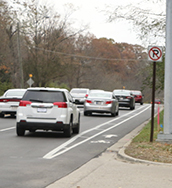Bike lanes added to East 56th Street
Lanes should increase safety, school president says

The bike lanes begin just east of campus. So far, they have not affected the flow of traffic.
After three months of traffic-inducing construction, the orange cones have finally vacated 56th Street. However, the construction workers left behind an unexpected gift: bike lanes.
In order to fit the bike lanes onto the street, the layout of the road needed significant alteration. President Mr. Rob Bridges said, “They tore the median out, and then they narrowed each car lane by one foot.”
He said, “It’s called a buffered bike lane because there is a thick stripe, so there’s a little bit of room left if everybody stays where they’re supposed to.”
Even with the built-in buffer, the small area of the lane still creates safety issues. “I actually did see someone on the bike lane yesterday, but I don’t think they’re very wide, so part of him was out over the white line,” Bridges said.
The main way to ensure safety for both bikers and drivers on 56th Street is simple: everyone on the road must become more aware of their surroundings. “I think people are going to have to pay more attention, and be more careful and slow down,” Bridges said.
However, the bike lanes—the supposed cause of the safety issue—are intended to be the solution to their own problem. “The research says that bike lanes calm the traffic. People automatically slow down. Hopefully that turns out true,” Bridges said.
Bridges still cautions students about the use of the bike lane. He said, “I always hope for the best, but as a dad and as a school president, we have to prepare for the worst.”
Since the school is located on 56th Street, the construction workers asked for the administration’s input on the bike lanes. Bridges said, “We were asked by the project managers what we thought. We did a little informal survey, and (the results) came out that 11 staff responded saying yes and around 50 responded saying no. (The project manager) got very excited that there were 11 people in favor of it. But I reminded him that there were five times that against it.
“I think the fact that there were 11 in support made him think maybe (the bike lanes) will get used. I don’t know how much that was used in the decision, but I know they considered that a data point to support bike lanes.
Bridges continued to emphasize the importance of caution. “Having more bike lanes is better, but safety, for me, still trumps all the benefits of bike lanes.”






